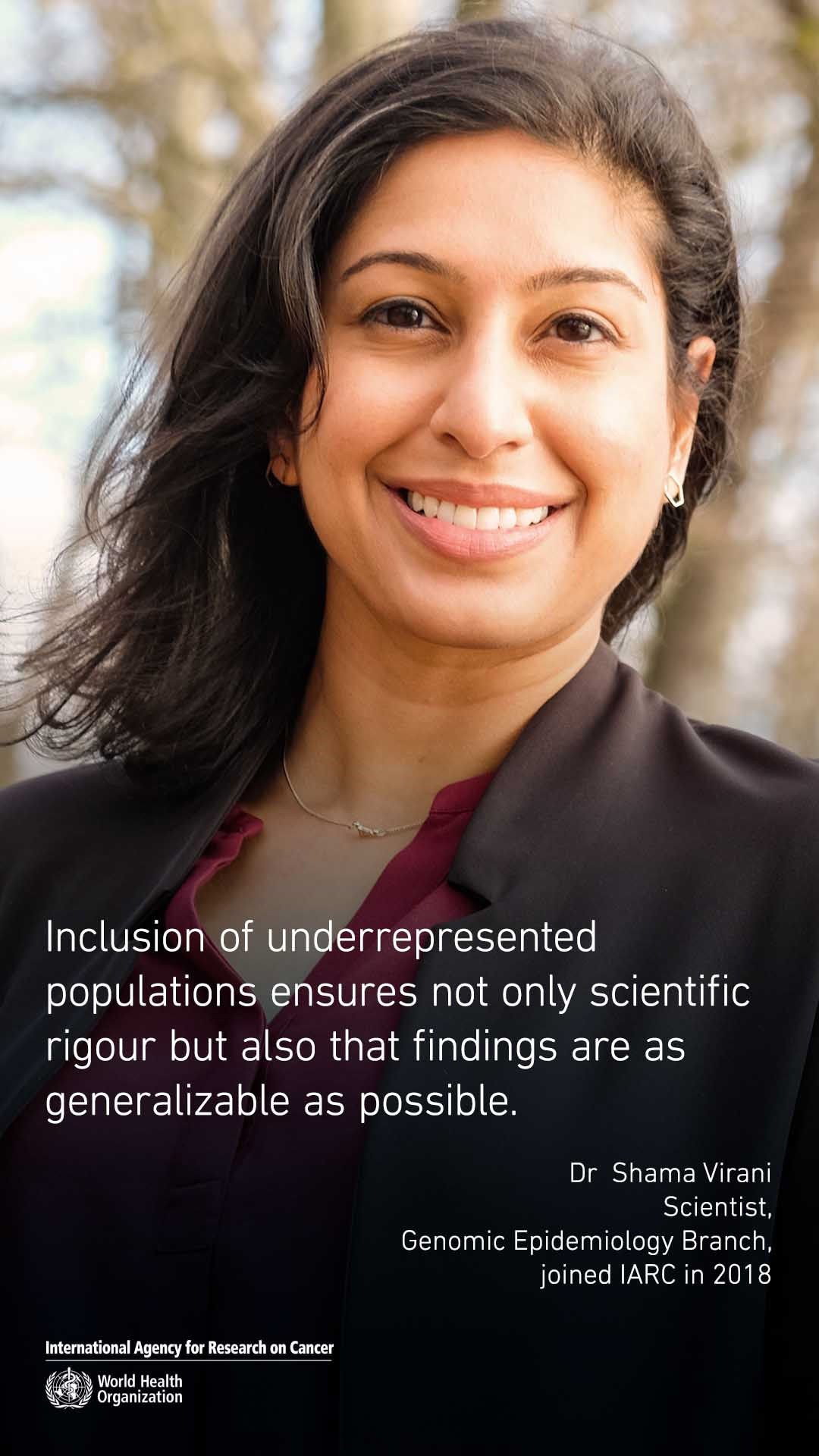Portraits of Scientists Home
❝Inclusion of underrepresented populations ensures not only scientific rigour but also that findings are as generalizable as possible.❞
Please introduce yourself. How long have you worked at IARC, and where did you work before?
I’m Dr Shama Virani of the Genomic Epidemiology Branch at IARC. I’ve been at IARC for 3 years. Before coming to IARC, I was living in southern Thailand on a Fogarty Global Health Fellowship, working with cancer registries and starting their first breast cancer case–control study. I received my PhD and a Certificate in Global Public Health from the University of Michigan School of Public Health, in Toxicology and Environmental Health Sciences.
What are the most interesting projects you are currently involved in, and why are they important?
I’m mostly involved in studies focused on the genomics of head and neck cancer. It’s not a cancer type people often think of at first, but it has a unique epidemiology depending on where in the world you’re looking and what site you’re considering. I’m particularly interested in cancers associated with human papillomavirus (HPV) infection.
The intersection of infections and cancer epidemiology is fascinating. Scientists have been very much focused on the human side of genomics, but it’s becoming clearer that viral genomics play an important role in the manifestation of cancer. The most challenging yet invigorating part of my work is the coordination of the scientific projects in two large head and neck cancer consortia, led by the Genomic Epidemiology Branch at IARC. I’ve met so many people around the world, and there is a rich exchange of ideas that is personally motivating.
Aside from the biology itself, understanding the genomic effects of known risk factors, such as smoking, alcohol consumption, and HPV infection, requires acknowledgement of the population being considered. It’s not just the presence of a risk factor that increases risk of cancer, it’s the magnitude. Culture, environment, and habits all play a role in determining this. Place this against the backdrop of genetic variation, which exists across populations and which influences how one’s biology reacts to these exposures, and you’ve got yourself a critical reason to include as many populations as you can. But the scientific rationale is really only half of the argument. Any findings that are made that become clinically translatable will be most applicable to those included in the studies. That makes the other half of the argument about equity. Inclusion of underrepresented populations ensures not only scientific rigour but also that findings are as generalizable as possible.
What do you do when you’re not doing research at IARC?
Depending on the time of year (yes, I’m from Chicago, but I can’t handle being cold), you’ll find me running and signing up for races in places I’d like to visit. I like to be outside, so you’ll find me camping or hiking in the mountains. I almost always have my Kindle with me, so you might find me reading on a park bench. If you have a nice kitchen, you might find me making you a meal in it. I have been known to randomly embark on long bike rides.
Why did you move into research?
I don’t think it’s ever been a question for me. I’ve always been plagued by this perpetual curiosity about things. I suppose I could have become an engineer or something else, but there is an appeal to working with people and making an impact in that way. I planned to be a bench scientist when I was in graduate school, but when I discovered population-based molecular epidemiology, there wasn’t much else to change my mind from going into it.
Which personal scientific contribution are you most proud of?
I led a pilot implementation study in southern Thailand where we tested willingness to use at-home cervical swab kits. Even though Pap smears in health clinics were covered through universal health care, Muslim women weren’t going to get the smear and they were dying from cervical cancer. Talking about this in a conservative community was not the easiest thing, but I took it in stride. We started the study with a discussion about cervical cancer and screening habits. When it came time to try the kit, I was miming and gesturing on how to use it, to the best of my ability, because my Thai translators were hesitant to be explicit outside of the written instructions. Afterwards, and as the paper later showed, each of the participants came out willing to use this kit, which was, in itself, an achievement. But seeing these women interact after trying the kit, watching them ask each other questions and understand that it could save their life, made me truly comprehend the importance of community-based interventions and how important the study was in this community. The impact was not very wide, but it was deep.
What is something you do now because of research you’ve read?
I try to get at least 20 minutes of exercise a day, breathe deeply, and remember that collaboration will always get you further than competition.
